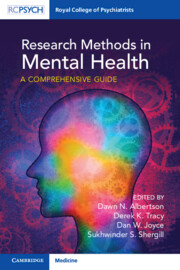Book contents
- Research Methods in Mental Health
- Reviews
- Research Methods in Mental Health
- Copyright page
- Contents
- Contributors
- Foreword
- Foreword
- Section 1 Principles of Research
- Chapter 1 The Foundations
- Chapter 2 Principles of Open Science
- Chapter 3 Writing Up Research
- Chapter 4 Equity, Diversity, and Inclusion in Academic Careers and Research
- Chapter 5 Changing Times – Patient and Public Involvement in Research
- Section 2 Tools and Methodologies
- Section 3 Contemporary Applications
- Index
- References
Chapter 2 - Principles of Open Science
from Section 1 - Principles of Research
Published online by Cambridge University Press: 31 October 2025
- Research Methods in Mental Health
- Reviews
- Research Methods in Mental Health
- Copyright page
- Contents
- Contributors
- Foreword
- Foreword
- Section 1 Principles of Research
- Chapter 1 The Foundations
- Chapter 2 Principles of Open Science
- Chapter 3 Writing Up Research
- Chapter 4 Equity, Diversity, and Inclusion in Academic Careers and Research
- Chapter 5 Changing Times – Patient and Public Involvement in Research
- Section 2 Tools and Methodologies
- Section 3 Contemporary Applications
- Index
- References
Summary
Recently, there has been growing awareness of the so-called ‘reproducibility crisis’ which refers to the failure to replicate the findings of many scientific studies. This may arise from the employment of questionable research practices, such as ‘p-hacking’ (conducting many statistical tests, and only reporting significant results), HARKING (hypothesising after the results are known), and outcome switching (promoting secondary outcomes to primary outcomes to fit unexpected results). Open Science practices, which encourage open methodology (including pre-registration of hypotheses and outcomes), open data (in a publicly accessible repository), and open access to publication (including pre-prints), are vital to combatting these. This chapter sets out how Open Science practices can be applied to psychiatric research, including consideration of challenges which can arise, such as how to share data safely and appropriately. The chapter includes an explanation of key principles and constructs, and explains how Open Science practises can be embedded throughout the life-cycle of a project, with practical how-to guides and sign-posting to further resources.
Keywords
Information
- Type
- Chapter
- Information
- Research Methods in Mental HealthA Comprehensive Guide, pp. 15 - 31Publisher: Cambridge University PressPrint publication year: 2025
References
Further Reading
References
Accessibility standard: WCAG 2.0 A
Why this information is here
This section outlines the accessibility features of this content - including support for screen readers, full keyboard navigation and high-contrast display options. This may not be relevant for you.Accessibility Information
Content Navigation
Allows you to navigate directly to chapters, sections, or non‐text items through a linked table of contents, reducing the need for extensive scrolling.
Provides an interactive index, letting you go straight to where a term or subject appears in the text without manual searching.
Reading Order & Textual Equivalents
You will encounter all content (including footnotes, captions, etc.) in a clear, sequential flow, making it easier to follow with assistive tools like screen readers.
You get concise descriptions (for images, charts, or media clips), ensuring you do not miss crucial information when visual or audio elements are not accessible.
Visual Accessibility
You will still understand key ideas or prompts without relying solely on colour, which is especially helpful if you have colour vision deficiencies.
Structural and Technical Features
You gain clarity from ARIA (Accessible Rich Internet Applications) roles and attributes, as they help assistive technologies interpret how each part of the content functions.
